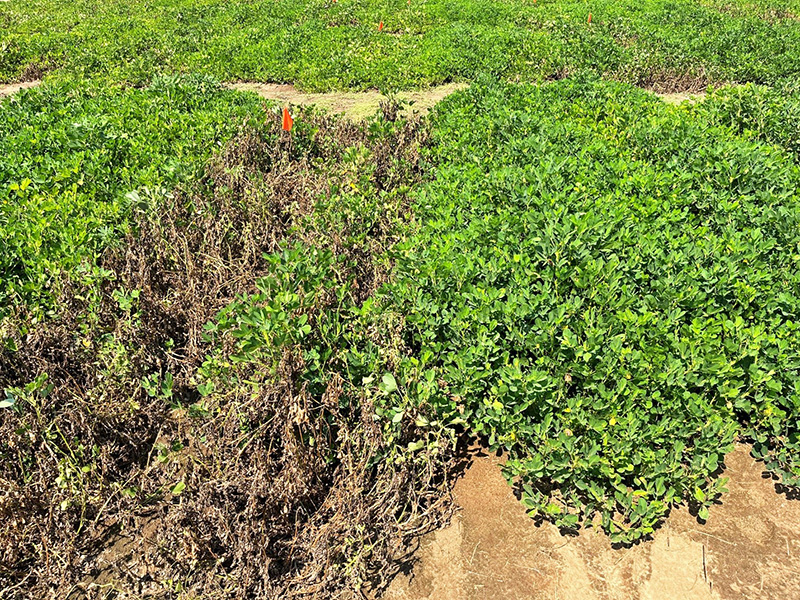Barry Tillman, UF/IFAS Peanut Breeder, North Florida Research and Education Center, Marianna
Have you ever leaned on something that looked sturdy but abruptly gave way under too much pressure? Gravity has no favorites and it’s relentless, so when the prop we are leaning on fails, and a fall happens, the landing can be hard and painful. Peanut diseases are a lot like gravity in one respect, they are relentless. They just need the right weather conditions, a peanut plant to two, and they will do their dirty, painful work, every time. Fortunately though, diseases show some favoritism depending on the variety of peanut they encounter. That’s because varieties differ in their level of susceptibility to diseases.
What does “level of susceptibility” mean? And why didn’t I say “level of resistance?” It’s purposeful, because I don’t think most of our peanut varieties have sufficient “resistance” to be leaned on too hard to minimize disease losses. Leaning too hard on a variety means using it as the primary method of disease control. That is likely to end badly. So, I prefer to say that all of our current varieties are susceptible to every major disease, but to different levels (not including root knot nematode- more later). Let me reiterate, every variety is susceptible to some degree to late leaf spot, early leaf spot, white mold and spotted wilt. If we understand that, hopefully we won’t lean on them more than is appropriate.
From here on, I am referring to the PeanutRx to classify variety disease resistance (2024 Peanut Rx Interactive Analysis Tool ). Let’s take white mold for instance. We can’t lean as heavily on a variety with 20 risk points for white mold (Georgia-06G, Georgia-16HO, Georgia-18RU, TifNV-HG, FloRun 52N, etc.) as we can on one with 10-15 risk points (Georgia-12Y, TifNV-HighOL, FloRun T61, etc.). In the same conditions we expect the less susceptible varieties to lose less yield than the more susceptible varieties. But that does not mean that the less susceptible variety will have no disease. It will, just less than the more susceptible one. To get the best from any of these varieties for white mold, the plan should include good crop rotation and a solid fungicide program.
In a “normal year,” most of our varieties can be protected reasonably well from white mold with a solid fungicide program and good rotation. But, when the perfect storm of weather and shorter crop rotation occurs, we will wish for much more to lean on than a variety. In 2023, we saw a perfect storm occur with white mold in Western Panhandle where even the least susceptible variety, Georgia-12Y, had a lot of white mold disease. To be sure, other, more susceptible varieties had even more losses in nearby fields, but the level of losses in the less susceptible variety was still more than one could stomach. The perfect storm included limited rainfall that prevented movement of fungicides from the leaves to the soil, shorter rotations, and high temperatures that favored the white mold fungus. And this is true for other diseases as well – when all the conditions favoring leaf spots or spotted wilt occur simultaneously, no current variety can stand up to the pressure alone.

Figure 1. A plot in Marianna, Florida in 2023 that crashed due to white mold beside one that is healthy. The only difference is that the fungus that causes white mold was spread over the plot on the left, but not on the plot on the right. Weather conditions in 2023 were very conducive to white mold development and this shows how devastating the disease can be when the weather is favorable, no fungicides are sprayed, and the fungus is abundant. Credit: Barry Tillman, UF/IFAS
–
None of our current varieties are immune to spotted wilt, so to minimize disease loss, we need to include the other factors known to reduce risk such as planting date, thimet/phorate, twin rows, and good plant stand. None of our varieties are immune to late or early leaf spot either, so we need to know the other risk factors like irrigation, excessive rainfall, and shortened rotations that contribute to disease and try to mitigate them. The one exception in peanut is resistance to root knot nematode (RKN). Varieties with resistance to RNK are nearly immune and can be reliable alone to minimize losses from RKN.
In summary, if your risk of white mold or leaf spots is increased due to shorter rotation or disease-favorable weather, consider bolstering the fungicide program. It’s too late to do anything about spotted wilt this year, but next year before planting, do all you can to minimize spotted wilt disease risk from the beginning. And remember, don’t lean too hard on your variety or it may crash.
- FloRun™ ‘725’ – A New High Yielding, Disease Resistant Peanut Variety - April 4, 2025
- Don’t Lean Too Hard on Your Peanut Variety for Disease Resistance - June 28, 2024
- ‘Arnie’ – A New Peanut Variety Released by the University of Florida - February 2, 2024
